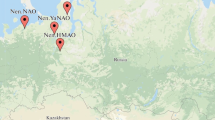Abstract
A comparative analysis of population-genetic structures of three indigenous sheep breeds (Kalmyk, Edilbay, and Karachay breeds) and closely related wild species of the European Mouflon has been performed with polylocus genotyping at the highly polymorphic fragments of genomic DNA flanked by inverted repeats of microsatellite loci and a long terminal repeat region of endogenous retrovirus BERV-K1 (ISSR-PCR and IRAP-PCR markers). Increased genetic heterogeneity of ISSR-PCR and IRAP-PCR markers in males compared to females is revealed in all of the tested animal groups. The spectra of amplification products, including breed- and species-specific genomic DNA fragments, are identified. Genotyping for them may contribute to the control over the process of consolidation of breeds and intrabreed groups. Representatives of the European Mouflon are found to be different from the domesticated sheep in higher-rank polymorphism in the fragments of genomic DNA flanked by inverted repeats of BERV-K1, which may indicate the mobile genetic elements involved in the population-genetic differentiation between the domesticated and closely related wild species.



Similar content being viewed by others
REFERENCES
Zeder, M.A., Core questions in domestication research, Proc. Natl. Acad. Sci. U. S. A., 2015, vol. 112, no. 11, pp. 3191–3198.
Glazko, V.I., Nikolai Vavilov… Zhizn’ kak sluzhenie Rodine 1940–1943 (Nikolai Vavilov… Life as a Service to the Motherland 1940–1943), Moscow: Kurs, 2019, vol. 2.
Moczek, A.P., Sultan, S., Foster, S., Ledón-Rettig, C., Dworkin, I., Nijhout, H.F., Abouheif, E., and Pfennig, D.W., The role of developmental plasticity in evolutionary innovation, Proc. Biol. Sci., 2011, vol. 278, pp. 2705–2713.
Colino-Rabanal, V.J., Rodriguez-Díaz, R., Blanco-Villegas, M.J., Peris, S.J., and Lizana, M., Human and ecological determinants of the spatial structure of local breed diversity, Sci. Rep., 2018, vol. 8, no. 1, p. 6452.
Donohue, K., The epigenetics of adaptation: Focusing on epigenetic stability as an evolving trait, Evolution, 2014, vol. 68, no. 3, pp. 617–619.
Hare, B., Plyusnina, I., Ignacio, N., Schepina, O., Stepika, A., Wrangham, R., and Trut, L., Social cognitive evolution in captive foxes is a correlated by-product of experimental domestication, Curr. Biol., 2005, no. 15, pp. 226–230.
Zimin, A.V., Delcher, A.L., Florea, L., Kelley, D.R., Schatz, M.C., Puiu, D., et al., A whole-genome assembly of the domestic cow, Bos taurus,Genome Biol., 2009, no. 10, p. 42.
Zietkiewicz, E., Rafalski, A., and Labuda, D., Genome fingerprinting by simple sequence repeat (SSR)-anchored polymerase chain reaction amplification, Genomics, 1994, vol. 20, no. 2, pp. 176–183.
Kalendar', R.V. and Glazko, V.I., Types of molecular genetic markers and their application, Fiziol. Biokhim. Kult. Rast., 2002, vol. 34, no. 4, pp. 279–295.
Kalendar, R. and Schulman, A.H., Transposon-based tagging: IRAP, REMAP, and iPBS, Methods Mol. Biol., 2014, no. 1115, pp. 233–255.
Mei, C., Wang, H., Liao, Q., Wang, L., Cheng, G., Wang, H., Zhao, C., Zhao, S., Song, J., Guang, X., Liu, G.E., Li, A., Wu, X., Wang, C., Fang, X., et al., Genetic architecture and selection of Chinese cattle revealed by whole genome resequencing, Mol. Biol. Evol., 2017, vol. 35, no. 3, pp. 688–699.
Yang, J.F., Ding, X.F., Chen, L., Mat, W.K., Xu, M.Z., Chen, J.F., Wang, J.M., Xu, L., Poon, W.S., Kwong, A., Leung, G.K., Tan, T.C., Yu, C.H., Ke, Y.B., Xu, X.Y., et al., Copy number variation analysis based on aluscan sequences, J. Clin. Bioinf., 2014, vol. 4, no. 1, p. 15.
Baba, K., Nakaya, Y., Shojima, T., Muroi, Y., Kizaki, K., Hashizume, K., Imakawa, K., and Miyazawa, T., Identification of novel endogenous betaretroviruses which are transcribed in the bovine placenta, J. Virol., 2011, vol. 85, no. 3, pp. 1237–1245.
Torresi, C., Casciari, C., Giammarioli, M., Feliziani, F., and De Mia, G.M., Characterization of a novel full-length bovine endogenous retrovirus, BERV-β1, Arch. Virol., 2015, vol. 160, no. 12, pp. 3105–3114.
Nei, M., Genetic distance between populations, Am. Nat., 1972, vol. 106, no. 949, pp. 283–292.
Zamani, W., Ghasempouri, S.M., Rezaei, H.R., Naderic, S., Hesari, A.R.E., and Ouhrouch, A., Comparing polymorphism of 86 candidate genes putatively involved in domestication of sheep, between wild and domestic Iranian sheep, Meta Gene, 2018, vol. 17, pp. 223–231.
Glazko, V.I., Genetic and genomic signatures of domestication, S-kh.Biol., 2018, vol. 53, no. 4, pp. 659–672.
Author information
Authors and Affiliations
Corresponding author
Ethics declarations
Conflict of interest. The authors declare that they have no conflict of interest.
Statement of the welfare of animals. All applicable international, national, and/or institutional guidelines for the care and use of animals were followed.
Additional information
Translated by O. Zhiryakova
About this article
Cite this article
Glazko, V.I., Kosovsky, G.Y., Erkenov, T.A. et al. Population Genetic Relationships between Mouflon and Domesticated Sheep Breeds in Highly Polymorphic Genomic Elements. Russ. Agricult. Sci. 46, 509–513 (2020). https://doi.org/10.3103/S1068367420050079
Received:
Revised:
Accepted:
Published:
Issue Date:
DOI: https://doi.org/10.3103/S1068367420050079




